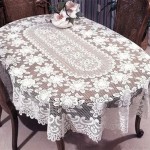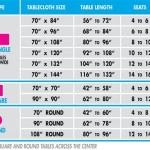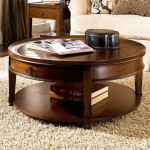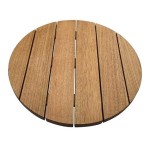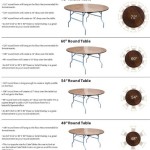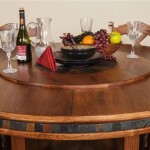Round 60 Inch Tables: Everything You Need to Know
Round 60-inch tables are a versatile and practical choice for various settings, ranging from residential dining rooms to commercial event spaces. Their circular shape promotes conversation and inclusivity, while their sizable diameter offers ample surface area for numerous guests or extensive displays. Understanding the nuances of these tables – their dimensions, capacity, materials, and optimal usage scenarios – is crucial for making an informed purchase decision.
This article provides a comprehensive overview of round 60-inch tables, covering essential aspects such as dimensions and seating capacity, material options and durability considerations, common uses and space planning strategies, and maintenance and care guidelines. By exploring these factors, readers can gain valuable insights into the benefits and limitations of these tables, enabling them to select the most appropriate option for their specific needs.
Dimensions and Seating Capacity
A 60-inch diameter translates to five feet across the table's surface. This substantial size allows for a comfortable seating arrangement for a specific number of individuals, which is a critical factor for both everyday use and special events. While the exact count depends on the size of the chairs and the desired level of personal space, a reasonable estimate is that a 60-inch round table comfortably accommodates between 8 and 10 people.
When planning seating arrangements, it's essential to consider the elbow room required for each guest. An average person needs approximately 24 to 30 inches of width at the table. Overcrowding not only makes dining uncomfortable but also hinders conversation and overall enjoyment. Therefore, carefully measuring and planning the chair spacing around the table is paramount to ensuring a positive experience for everyone seated. Furthermore, the specific design of the table base should be taken into account. A pedestal base allows for more legroom than a table with four legs, which can sometimes constrain seating arrangements.
In addition to seating capacity, the height of the table is a key dimension to consider. Standard dining table height is typically between 28 and 30 inches. This height is optimized for comfortable dining and allows for adequate legroom beneath the table. However, different heights may be desired for specific uses. For example, a taller 36-inch high table might be preferred for bar-style seating or a gathering spot in a kitchen. Conversely, a coffee table version would be significantly lower.
Material Options and Durability Considerations
Round 60-inch tables are available in a wide array of materials, each offering distinct aesthetic qualities, durability characteristics, and maintenance requirements. Common material choices include wood, metal, glass, laminate, and composite materials. The selection should align with the intended use of the table, the desired aesthetic, and the anticipated level of wear and tear.
Wood tables offer a classic and timeless appeal, providing warmth and character to any room. Hardwoods like oak, maple, and cherry are known for their durability and resistance to scratches and dents. Softwoods, such as pine, are more susceptible to damage but can be a more affordable option. The finish applied to a wooden table significantly impacts its durability and resistance to stains and moisture. A sealant or varnish provides a protective layer, while a stain enhances the wood's natural grain patterns.
Metal tables, particularly those made of stainless steel or wrought iron, are known for their strength and longevity. Metal tables are often used in outdoor settings or commercial spaces owing to their resistance to weather and heavy use. A powder coating can enhance the metal's resistance to rust and corrosion, extending its lifespan. However, metal tables can feel cold or industrial depending on the design and surrounding décor.
Glass-top tables offer a sleek and contemporary look, creating a sense of openness and lightness in a room. Tempered glass is the optimal choice for table tops due to its strength and safety characteristics. If broken, tempered glass shatters into small, dull pieces, reducing the risk of injury. Glass tables can be prone to scratches and fingerprints, requiring frequent cleaning. The base material supporting the glass top is also a crucial consideration, as it contributes to the overall stability and style of the table.
Laminate tables are constructed from a composite core overlaid with a thin layer of laminate. This material is highly durable, scratch-resistant, and easy to clean, making it an ideal option for high-traffic areas or households with children. Laminate tables are also available in a wide range of colors and patterns, mimicking the look of wood or stone at a lower cost. However, laminate tables may lack the natural grain and warmth of solid wood.
Composite materials, such as resin or acrylic, offer a unique combination of durability and design flexibility. These materials can be molded into various shapes and colors, creating visually striking tables that are resistant to water and UV damage. Composite tables are suitable for both indoor and outdoor use, making them a versatile choice for different settings.
Common Uses and Space Planning Strategies
Round 60-inch tables are adaptable to a variety of uses and settings, ranging from formal dining rooms to casual breakfast nooks and commercial event spaces. Their circular shape promotes interaction and facilitates conversation among guests, making them an ideal choice for gatherings and social events. The size of the table allows for ample surface area for meals, games, or displays, while the round shape creates a sense of inclusivity and equality among participants.
In residential settings, round 60-inch tables are often utilized as dining tables in kitchens, dining rooms, or breakfast areas. They can also serve as game tables in recreation rooms or as display tables in entryways or living rooms. The versatility of these tables allows them to adapt to different needs and preferences, making them a valuable asset in any home.
In commercial environments, round 60-inch tables are frequently used for banquet halls, conference rooms, or restaurant settings. Their ability to comfortably seat 8 to 10 people makes them an efficient choice for seating large groups. They are also well-suited for showcasing products or displays in retail environments or trade shows. The circular shape can encourage browsing and interaction with the displayed items.
When planning the layout of a room with a round 60-inch table, it's crucial to consider the overall dimensions of the space and the desired amount of walking space around the table. A general rule of thumb is to allow at least 36 inches of clearance between the table and any walls or other furniture. This ensures that people can comfortably move around the table without bumping into obstacles. For high-traffic areas, a clearance of 48 inches or more may be desirable.
The placement of the table within the room can also significantly impact the flow of traffic and the overall aesthetic. Centering the table in the room can create a sense of balance and harmony, while placing it off-center can create a more dynamic and informal feel. Consider the location of doors, windows, and other architectural features when determining the optimal placement of the table.
Choosing the appropriate chairs to complement the round 60-inch table is also crucial for both comfort and aesthetics. The chairs should be proportional to the size of the table and should provide adequate support and comfort for seated guests. The style of the chairs should also complement the table's design and the overall décor of the room. Upholstered chairs can add a touch of elegance and comfort, while wooden or metal chairs can create a more minimalist or industrial look.
Lighting plays a crucial role in setting the mood and highlighting the table. A chandelier or pendant light hanging directly above the center of the table can create a focal point and provide ample illumination for dining or other activities. Recessed lighting or wall sconces can provide ambient lighting, creating a warm and inviting atmosphere. Dimmer switches allow for adjusting the light levels to suit different occasions and moods.
Maintenance and Care Guidelines
Proper maintenance and care are essential for preserving the appearance and prolonging the lifespan of a round 60-inch table. The specific cleaning and maintenance procedures will vary depending on the table's material, finish, and frequency of use. Regular cleaning and prompt attention to spills and stains can prevent permanent damage and keep the table looking its best.
For wooden tables, regular dusting with a soft cloth is recommended to remove dust and debris. A damp cloth can be used to wipe up spills, but it's important to dry the surface immediately to prevent water damage. Avoid using harsh chemicals or abrasive cleaners, as they can damage the finish. Wood furniture polish can be used periodically to restore the wood's luster and protect it from scratches and fading. For tables with a varnish or sealant, a commercial furniture cleaner can be used to remove stubborn stains.
Metal tables can be cleaned with a damp cloth and mild detergent. Avoid using abrasive cleaners or scouring pads, as they can scratch the surface. For stainless steel tables, a stainless steel cleaner can be used to remove fingerprints and water spots. Protect metal tables from prolonged exposure to moisture to prevent rust formation. Applying a rust inhibitor can also extend the lifespan of metal tables used in outdoor environments.
Glass-top tables require frequent cleaning to remove fingerprints, smudges, and dust. A glass cleaner and a soft cloth are sufficient for most cleaning tasks. Avoid using abrasive cleaners, as they can scratch the glass surface. For stubborn stains, a mixture of vinegar and water can be used as a natural cleaning solution. Be sure to dry the glass surface thoroughly after cleaning to prevent water spots.
Laminate tables are relatively easy to clean and maintain. A damp cloth and mild detergent are typically sufficient for removing dirt and spills. Avoid using abrasive cleaners or scouring pads, as they can damage the laminate surface. For stubborn stains, a commercial laminate cleaner can be used. Protecting laminate tables from excessive heat and moisture can prevent warping or peeling.
Composite tables can be cleaned with a damp cloth and mild detergent. Avoid using harsh chemicals or abrasive cleaners, as they can damage the material. For stubborn stains, a commercial cleaner specifically designed for composite materials can be used. Composite tables are generally resistant to water and UV damage, making them suitable for both indoor and outdoor use.

Lifetime 60 Inch Round Table Professional

Lifetime 60 Inch Round Nesting Table Commercial

Lifetime 60 Almond Round Folding Table 280435

Lifetime Round Folding Table 60 Plastic White Granite 4 Pack

60 Round Table Seat 8 To 10 Destination Events

Lifetime 4 60 Inch Round Stacking Tables And 32 Chair Combo

60 In Round Table A E Als Llc

Acme Vendome Dining Table Cherry

60 Round Al Tables Jms Tents Party Als

Cylinder Round Dining Table
Related Posts

